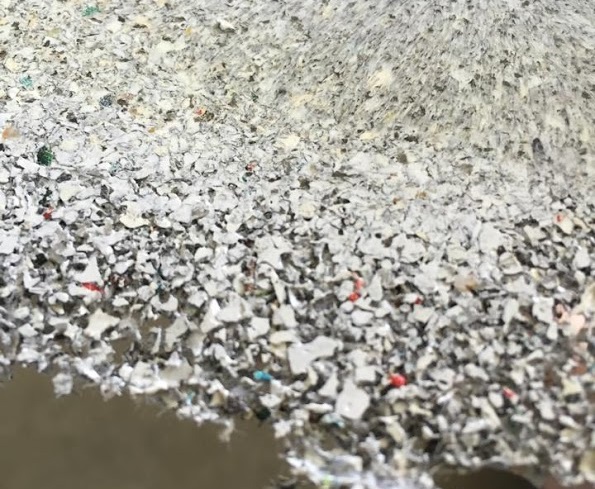As recently as four years ago, polyvinyl chloride (PVC) was so difficult to recycle that people would pay for scrap PVC to be taken away. PVC is a durable and long-lived polymer. It is used in all kinds of things, from flooring to cables and medical supplies.
“People would pay us to collect PVC. The going rate was $150 a ton for us to collect it,” said Jack Fitzgerald, Director of Think Fencing at Port Arlington in Victoria. As manufacturers of fencing and decking products, Think Fencing became interested in recycling PVC around 10 years ago.
“I was very much motivated by sustainability,” said Fitzgerald. “I was going out to companies that manufacture PVC. Mindboggling amounts was going into landfill. The questions I asked back in my naïve days is why aren’t we recycling this? Why can’t we use it?”
PVC recycling in Australia
PVC is one of the top four polymers consumed in Australia by weight. However, according to the Australian Plastics Recycling Survey for 2018-19, it had one of the lowest reported recovery rates of any polymer. These rates can be difficult to measure accurately in the case of a long-lived polymer such as PVC. To address this, a team at CSIRO has interviewed manufacturers and recyclers to learn more about the issue.
CSIRO has generated a report, PVC Recycling in Australia. The work, being is being led by CSIRO’s Dr Qamar Schuyler as part of CSIRO’s Ending Plastic Waste Mission.
“What emerged from speaking to a number of different manufacturers was that it is very hard to assess the material composition of a sample of shredded PVC,” Dr Schuyler said.
“As a recycler or compounder they are bringing in used PVC to turn into recycled PVC pellets. It’s hard to accept samples that are pre-ground because you don’t know what they are made of. So it becomes really hard to work with it. Quality control is really quite challenging.”
PVC formulations
According to Fitzgerald there are around 5000 different formulations of PVC in use in Australia. These different formulations provide PVC with the specific properties that make it useful for a wide range of products. From shoe soles to hoses to guttering and IV bags in hospitals. This diversity makes PVC challenging to recycle because you need to know what’s in your PVC. This is potentially a technically challenging and costly task.
“The only way to recycle material is to get a batch of a known formulation. You would then test that material and find out how much heat stabiliser is in it. You would then slowly add additional heat stabilisers and lubricants to that formulation until it processes the way it should.” explained Fitzgerald.
Incorporating recycled PVC into products
The CSIRO report found that in Australia with small volumes and large distances, the cost of logistics is another challenge for recycling PVC. Long-lived and used predominantly in construction and infrastructure, PVC can often be too contaminated to be recycled.
Historically, using virgin PVC resin has provided a number of benefits over recycled including cost and colour. This has given manufacturers little incentive to utilise recycled PVC in their products.
But with a number of converging factors on the horizon, recycled PVC may soon have its day in the sun. Commodity prices for PVC resin have risen steeply. This provides a financial incentive to utilise recycled PVC in manufacturing. Plastic waste is a major environmental issue and Australian consumers are demanding change. The Australian Government has set a target of 80% waste recovery by 2030 in its National Waste Action Plan.
Over the last decade, Think Fencing has developed products and processes that allow them to utilise a proportion of recycled PVC in their fence and decking products. They are teaming up with a cross-disciplinary team at CSIRO, led by Dr Schuyler, to take things to the next level.
The project, funded by Sustainability Victoria, aims to develop a tool that can analyse the composition of PVC. This could allow PVC of otherwise unknown origin and composition to be recycled. This would save it from landfill.
“Having a pre-knowledge of what you’ve got in a sample is going to expand the scope of PVC that can be recycled,” Dr Schuyler said.
Breaking down material specifications
Dr Schuyler’s team are currently exploring which technology will work best in the analyser tool. Once the device is developed, it will be tested with Think Fencing’s PVC extrusion system, inline or as a standalone device. The aim is for the device to analyse the percentage of PVC in a sample. It will also analyse the lubricant, filler and heat stabiliser used. Recyclers can then use this information to tell them what additives are required to recycle the material.
Fitzgerald says the analyser could be a game changer.
“The potential is huge,” he said. “We will be able to basically take any rigid PVC from anywhere and produce a finished product.”

Following the development of the analyser, CSIRO plans to develop a sample library that will operate almost like a recipe book. It will provide recyclers with recipes to produce particular materials out of the PVC ingredients they have available.
Dr Schuyler’s team will also work to draft material specifications to guide manufacturers in relation to the characteristics of recycled PVC.
“The idea of having material specifications gives both the manufacturers, as well as the recyclers, something to shoot for,” she said.
“The development of standards for PVC recycling can help to overcome one of the biggest challenges for recycling PVC – the perception by some that it is worthless. Standardisation across the PVC value chain from manufacturer to finished product could shift the perception of recyclable material from ‘scrap’ to ‘commodity’.”
